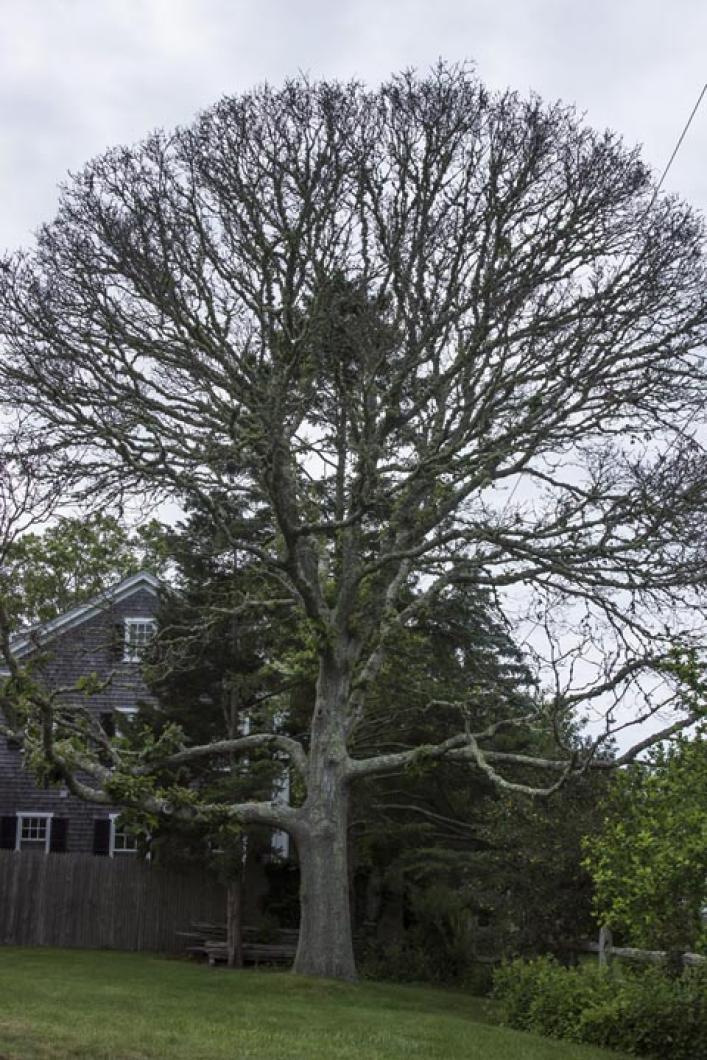Inside the Polly Hill Arboretum office on Monday afternoon sits Collections and Grounds Manager Tom Clark with a number of black oak twigs and branches on his desk, one just brought in by arborist John McCarter an hour earlier. With acorns dangling and new foliage sprouting, the twigs are seemingly healthy.
Look closer and each twig has hundreds of miniscule holes; the once smooth, skinny branches are now bumpy and swollen.
Once emerging from these tiny holes were the cynipid gall wasps currently attacking black oak trees up and down the Island.
Mr. Clark believes that the wasp has infected black oak trees (also known as Quercus velutina), and tends to target previously stressed oaks.
“When the oaks expand their first flush of growth, those twigs are very soft and supple,” said Polly Hill Executive Director Tim Boland. “It appears that’s when the wasps deposit their eggs into that soft tissue.”
Mr. Clark said the galls, or abnormal plant outgrowths, on the branches could be a result of the tree responding to a chemical produced by the wasp. But he does not know for sure.
It is apparent, however, that infected trees are struggling to pump water through their vascular system. The galls clog the piping of the tree, and water cannot be distributed to the branches or leaves, said Mr. Boland.
Examining one of the branches in his office, Mr. Clark points out the green growth sprouting from the bumpy, infected branch.
“The fact that it’s pushing out new growth indicates that, yes, the tree branch is still alive,” he said. “But there may not be the ability to conduct enough water to that new tissue to keep it alive.”
Mr. Boland said the extent, and effect of the infestation, is not yet clear.
Scattered reports of cynipid wasp activity have been reported on Martha’s Vineyard in the past few years, but never to this extent.
A few weeks ago Mr. Boland got a call from a woman on Chappaquiddick concerning her black oak, describing the pinholes on the branches.
After Chappy, there were calls from Edgartown, Vineyard Haven and Oak Bluffs.
Just this week came a report from Aquinnah.
And it’s not just homeowners calling for information.
“We’ve had a call from every arborist on the Island,” said Polly Hill Volunteer Coordinator and Plant Recorder Nancy Weaver as she peered through a telescope into the tiny holes of the branch.
“It hasn’t been given a lot of attention,” said Mr. Clark. “Now, with a situation like this, where we are seeing it more, and not only seeing it more, but seeing negative affects on trees . . . that’s when people really sit up and take notice.”
“We don’t have a clear understanding just yet of how significant a problem this is, but we do understand it to be more widespread than before,” said Mr. Boland.
Mr. Clark said it’s important to keep in mind that trees do not always show signs of stress or infection immediately. It can take years for symptoms to appear.
And not only are the symptoms inconsistent — in addition to the tiny holes and swollen branches, the trees can eventually lose their leaves due to lack of water flowing through the vascular system — information on the wasp is very limited. The arborists at Polly Hill still have much to investigate.
“We are still trying to figure out the exact life cycle,” said Mr. Boland. “We don’t know if it is a native or exotic pest. We aren’t sure if it persists for a long time or if the population crashes.”
Experts say the trees are extremely hard to treat, both because the life cycle of the wasp is relatively unknown at the moment and the galls it produces on the trees act as protection for the wasps within.
“I could talk for hours about caterpillar control, but this insect is inside the twig,” said Robert Hagerty of Hagerty Tree Service.
Hagerty and his crew first saw symptoms of the cynipid wasp in 2009. Since then they have tried a number of techniques, including soil injections, trunk injections and spraying the trees.
“Whether or not we get results, well, it’s too early to tell,” Hagerty said. “But we’ve saved some trees in the past years.”
Polly Hill staff recently learned of a similar infestation that occurred in Long Island in 2007, one of the first places where the cynipid gall wasp and black oak association was reported, said Mr. Boland. They have attempted to contact colleagues in Long Island who researched the cynipid gall wasp in hopes of gaining more information about the life cycle of the wasp, long term affects on the trees and how to treat the insect.
“When you look at the geology of Martha’s Vineyard and the way our soils are and the distribution of plants, it’s all strikingly similar to Long Island,” Mr. Boland said.







Comments (4)
Comments
Comment policy »